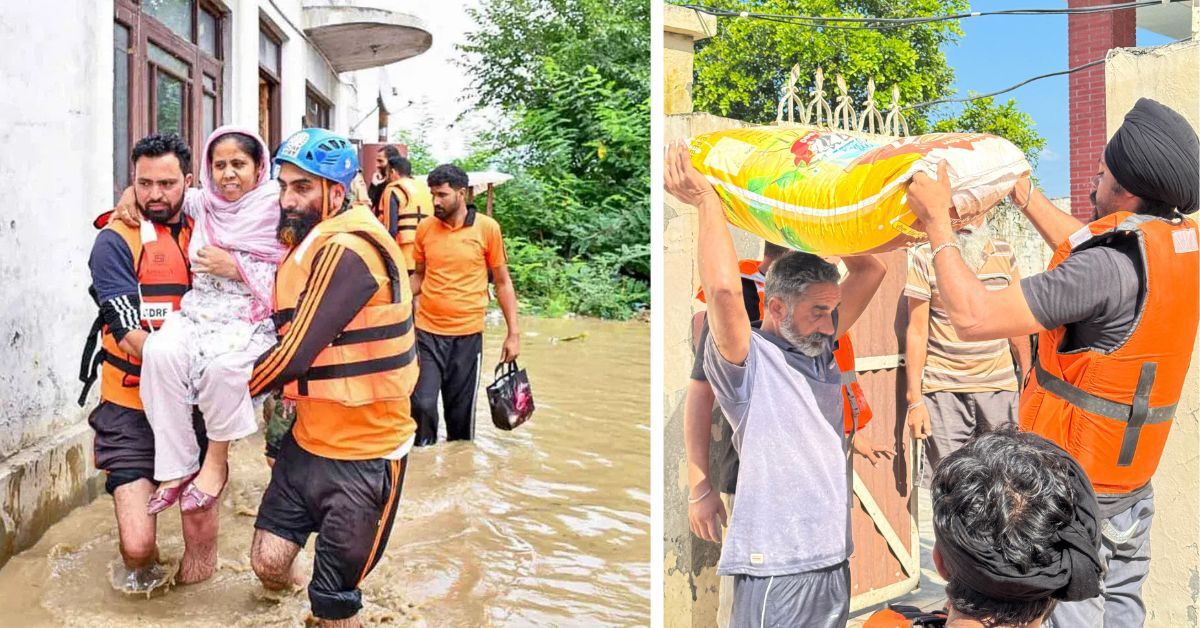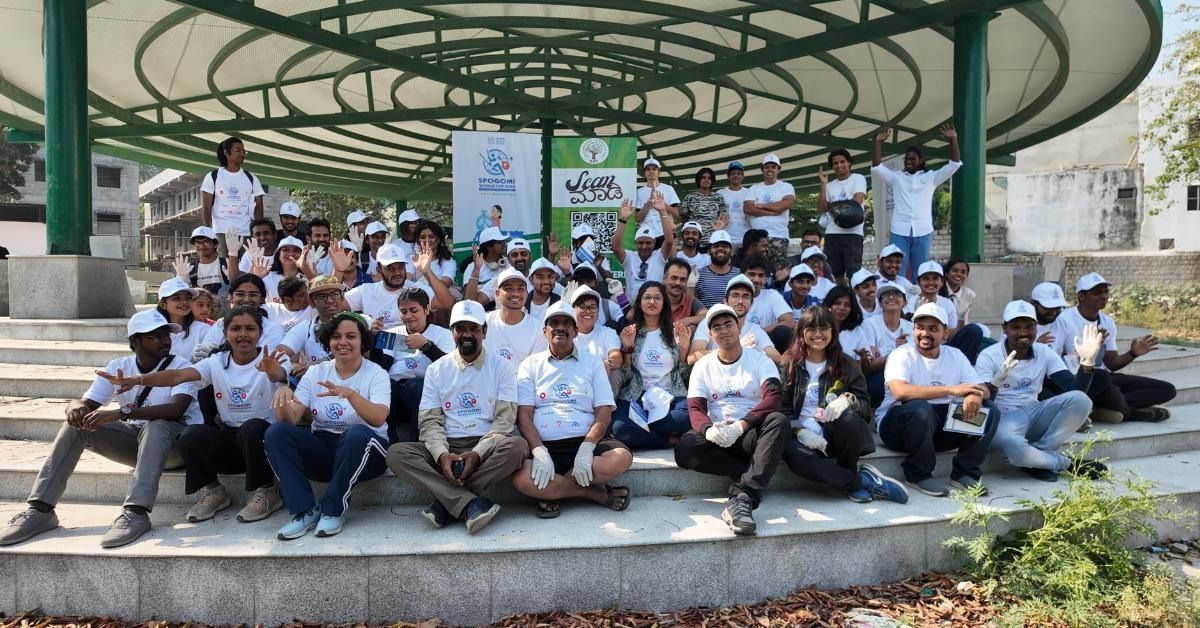Farmer Mohan Singh was preparing to harvest the kharif crops on his field this week. He was elated; it had been a great season. So picture his devastation when he walked out onto his field three days ago, and saw that the green had been replaced by steadily rising water. Mohan belongs to Gurdaspur in Punjab, which is inundated by the waters flooding the state. The relentless heavy rains are compounded by the dangerously high levels of the Sutlej, Beas, and Ravi rivers.
Punjab is drowning. It needs your help.
Donate to help Punjab flood victims
Farmer Mohan, like the 3,54,000 people (as of 5 September) affected, did not have time to grieve. His only priority was ensuring that his family made it out of the house alive. But there was no escape; the only option was to wait and pray.
And then, they saw a boat making its way to them. In it was Harmeet Singh, who leads CSR (Corporate Social Responsibility) at Punjab-based NGO Kalgidhar Trust, one of the many conducting relief and rescue operations on the ground supported by Donatekart.
There was no possibility of salvaging the house or any of the farmer’s belongings, recalls Harmeet. But as they journeyed on the boat to the relief camp in Gurdaspur, Mohan broke down, “My fields are gone. I know I might not be able to sow anything for another year until the soil becomes fertile again and the mud is removed. What am I going to do?”
Relief and rescue operations are underway to support people affected by the Punjab floods.
Harmeet did not have the answers. He admits that, despite having conducted relief and rescue operations for the last two decades, they are daunted by the scale of the calamity — these are being called the worst floods that the city has experienced since 1988. As of 2:30 PM on 5 September 2025, the death toll stands at 43, with 1,48,000 hectares of agricultural land submerged under water and with it, thousands of dreams. Punjab is the seat of India’s agrarian economy, and a calamity of this scale will ripple into effects that are felt across the country.
Advertisement
While it will take time to bring the situation under control, The Better India is joining hands with Donatekart to help. And you can join us too, by donating to this fundraiser.
Help the people of Punjab: What can you do?
Click on this link to donate to the fundraiser.
Your donations will be directed towards procuring relief kits and boats.
Each relief kit will contain items like bedsheets, blankets, mosquito nets, ready-to-eat items, ORS powder, clothes, and foldable beds.
Kalgidhar Trust is one of the many NGOs conducting relief and rescue operations on the ground, supported by Donatekart
It is important to note that while the NGO partners on the ground will be distributing the relief kits, the funds will be directly channelled towards procuring the necessary material and will not be directed to NGOs themselves.
Your money is directly helping a flood victim. Your donations will go towards:
Advertisement
1) airlifting the boats to the sites of rescue operations and
2) procuring relief material so that families can be helped once they are shifted to the relief centres.
The relief requirements of the people who are being sheltered at camps after being rescued
Schools & gurudwaras turn into relief camps
Elaborating on the necessity of boats during this time, Harmeet shares that these are of paramount importance in the Fazilka area of Punjab. “This is where the rivers meet, and so the impact of the flood is a lot. The water has increased to a high level here.” Boats are the only form of conveyance right now across the districts of Punjab: Gurdaspur, Kapurthala, Ferozepur, Amritsar, and Fazilka.
Across Punjab, gurudwaras, schools, and other public institutions have been turned into relief camps. The Kalgidhar Trust runs 100+ schools, and these too have been transformed into centres where people are being sheltered until the situation eases.
Across Punjab, gurudwaras, schools, and other public institutions have been turned into relief camps
It is heartwarming to see the boundaries of religion blur as people of all faiths come together to distribute the material. “We see volunteers of all faiths who have been working day and night to help out,” Harmeet shares. He tells the story of an elderly man whom they recently rescued. “He had lost everything in the flood water, but soon after he was on the boat with us, he asked for a life jacket and said, ‘I will come and help your team rescue others who are stuck.’”
Botas are being deployed to perform rescue operations in flood-affected Punjab
The government has taken cognisance of the scale of the disaster and deployed the NDRF, SDRF, Army, Air Force, BSF, and police. Evacuations and food drops are being supported by helicopters. There have been 438 rapid response teams, 360 mobile medical units, and 172 ambulances dispatched statewide. Boats are being deployed in remote areas like Gurdaspur to reach isolated populations, including pregnant women.
Advertisement
‘My house is flooded, but I must give you something to eat’
One of the only things that has kept Harmeet and his team, and the numerous other teams supported by Donatekart, going during this time has been the resilience they have seen among the people. “While performing the rescues, when we go to their homes, which are completely flooded, they still say, “My kitchen is flooded, but can I offer you some milk? You have come to my house, and I should give you something.”
There have been 438 rapid response teams, 360 mobile medical units, and 172 ambulances dispatched statewide
He tells another story of a rescue where a little girl began crying as she, along with her family, was taken away to the relief camp in the rescue boat. She watched her house, the one that her father had taken a loan for and put his life savings into building, crumble to pieces, washed away brick by brick. “But her father consoled her, ‘Houses can be rebuilt. At least we are alive.’”
These stories reveal the unbreakable spirit of the people, Harmeet points out.
But it’s going to take a great deal of time for the farmers to tide through the losses. “Their animals are drowning and dying; this is leading to an increase in infections. We have our doctors across medical centres and relief camps, but the number of cases of waterborne diseases, skin infections, and diseases caused by mosquito bites is on the rise.”
As for the scale of the losses, he says they will only be able to assess this once the flood waters ebb. However, the distress will continue for farmers like Mohan who do not have a home to go back to. It isn’t just the present that keeps him up at night, but the uncertain future.
But your donation can help bring comfort today and strength tomorrow — for Mohan, and for countless others like him.
Advertisement
All pictures courtesy Donatekart







